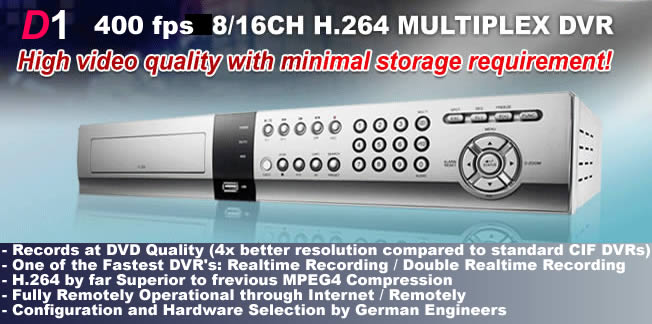DVR Analog Cam - MEDUSA CCTV
Main menu:
Tutorial > DVR / NVR
DVR ANALOG CAMERA (Old TVL Analog Cam)
Commercial websites use highly technical terminology in order to outline the advantages of DVR Models and other CCTV Equipment. But rarely is the customer given any clear explanation as to the meaning of those terms, making it difficult for the buyer to make a choice concerning the appropriate equipment. Please find a detailed definition of the most important DVR Specifications below.
A typical CCTV DVR Model

DVR Recording Resolution CIF, 2CIF, 4CIF, D1, Half D1
This is one of the two most important factors! There are three types of DVR Recording Resolution qualities: CIF, Half D1 and D1.
CIF: This is the lowest and out-dated resolution-quality. Video and picture is produced at 320 X 230 Pixels. Proper IDENTIFICATION of suspects is unlikely and chances of success in court rather dim - unless the incident occurred very close to the recording Security Camera. Distant subjects and objects become very unclear. Yet even many high profile security clients keep this as their standard recording format. There are a number of reasons for this, mainly being Frame Rate FPS (frames per second) and least but certainly not last to avoid 4CIF Line Interlacing
2CIF or Half D1: Semi Recording Quality / recommended only for home and small business use. Does not produce fully professional and reliable evidence in all situations. Up to 720 X 260 Pixels. CIF and 2CIF are sometimes preferred for frame rate advantages and in order to avoid Line Interlacing, but both video formats require close up camera positioning in order to reach chances of identification.
4CIF or D1: Records at up to 720 X 520 Pixels, which is similar to DVD Quality. In a professionally configured CCTV System even distant suspects have a chance of identification. 4CIF is not recommended for scenarios in which the to be identified individuals or subjects can be expected to move swiftly. This is due to the great downside of D1 / 4CIF being Line Interlacing.
FPS - Frames per Second - DVR Frame Rate
FPS Frames Per Second is one of the most crucial DVR function specification to be considered prior to the purchase of a DVR. The overal Frame Rate determines how many frames (images) per second can be recorded for each connected camera individually. FPS is usually (if not stated outherwise) based on recording resolution CIF. Increase of recording reslution from CIF to 2CIF or 4CIF (similar to D1 and DVD resolution) drastically reduces the maximum frames per second. In order to review more detailed information and a table of examples please click... more
Line Interlacing at 4CIF DVRs
Line Interlacing is the one great disadvantage of configuring a DVR to record in 4CIF Resolution. It causes a delay distortion of fast moving objects and subjects in every second horizontal video line... more
H.264 Compression Vs MPEG4
The new H.264 Video Compression is by far superior to the older MPEG4
Ideal CCTV highly recommends H.264 because:
- It saves almost 50 % of Hard Disk Space
- It reduces storage cost
- Greatly improves Remote Monitoring and View over the Web- Applications
- Faster Internet streaming